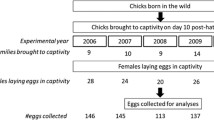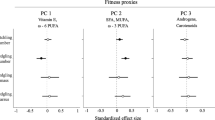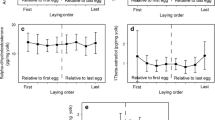Abstract
Egg components are important mediators of prenatal maternal effects in birds and other oviparous species. Because different egg components can have opposite effects on offspring phenotype, selection is expected to favour their mutual adjustment, resulting in a significant covariation between egg components within and/or among clutches. Here we tested for such correlations between maternally derived yolk immunoglobulins and yolk androgens in great tit (Parus major) eggs using a multivariate mixed-model approach. We found no association between yolk immunoglobulins and yolk androgens within clutches, indicating that within clutches the two egg components are deposited independently. Across clutches, however, there was a significant negative relationship between yolk immunoglobulins and yolk androgens, suggesting that selection has co-adjusted their deposition. Furthermore, an experimental manipulation of ectoparasite load affected patterns of covariance among egg components. Yolk immunoglobulins are known to play an important role in nestling immune defence shortly after hatching, whereas yolk androgens, although having growth-enhancing effects under many environmental conditions, can be immunosuppressive. We therefore speculate that variation in the risk of parasitism may play an important role in shaping optimal egg composition and may lead to the observed pattern of yolk immunoglobulin and yolk androgen deposition across clutches. More generally, our case study exemplifies how multivariate mixed-model methodology presents a flexible tool to not only quantify, but also test patterns of (co)variation across different organisational levels and environments, allowing for powerful hypothesis testing in ecophysiology.

Similar content being viewed by others
References
Rubolini D et al (2011) Maternal effects mediated by egg quality in the yellow-legged gull Larus michahellis in relation to laying order and embryo sex. Front Zool 8:24 doi:10.1186/1742-9994-1188-1124
Boonekamp JJ, Ros AHF, Verhulst S (2008) Immune activation suppresses plasma testosterone level: a meta-analysis. Biol Lett 4:741–744
Boulinier T, Staszewski V (2008) Maternal transfer of antibodies: raising immuno-ecology issues. Trends Ecol Evol 23:282–288
Buechler K, Fitze PS, Gottstein B, Jacot A, Richner H (2002) Parasite-induced maternal response in a natural bird population. J Anim Ecol 71:247–252
Cheverud JM, Moore AJ (1994) Quantitative genetics and the role of the environment provided by relatives in behavioral evolution. In: Boake CRB (ed) Quantitative genetic studies of behavioral evolution. The University of Chicago Press, Chicago, pp 67–100
Christians JK (2002) Avian egg size: variation within species and inflexibility within individuals. Biol Rev 77:1–26
Curno O, Behnke JM, McElligott AG, Reader T, Barnard CJ (2009) Mothers produce less aggressive sons with altered immunity when there is a threat of disease during pregnancy. Proc R Soc B 276:1047–1054
Ewen JG, Thorogood R, Brekke P, Cassey P, Karadas F, Armstrong DP (2009) Maternally invested carotenoids compensate costly ectoparasitism in the hihi. Proc Natl Acad Sci USA 106:12798–12802
Gasparini J, McCoy KD, Haussy C, Tveraa T, Boulinier T (2001) Induced maternal response to the Lyme disease spirochaete Borrelia burgdorferi sensu lato in a colonial seabird, the kittiwake Rissa tridactyla. Proc R Soc B 268:647–650
Gasparini J, McCoy KD, Staszewski V, Haussy C, Boulinier T (2006) Dynamics of anti-Borrelia antibodies in blacklegged kittiwake (Rissa tridactyla) chicks suggest a maternal educational effect. Can J Zool 84:623–627
Gasparini J, Boulinier T, Gill VA, Gil D, Hatch SA, Roulin A (2007) Food availability affects the maternal transfer of androgens and antibodies into eggs of a colonial seabird. J Evol Biol 20:874–880
Gil D (2008) Hormones in avian eggs: physiology, ecology and behavior. In: Brockmann HJ, Roper TJ, Naguib M, Wynne-Edwards KE, Barnard C, Mitani J (eds) Advances in the study of behavior, vol 38. Elsevier, Amsterdam, pp 337–398
Gil D, Marzal A, de Lope F, Puerta M, Moller AP (2006) Female house martins (Delichon urbica) reduce egg androgen deposition in response to a challenge of their immune system. Behav Ecol Sociobiol 60:96–100
Gilmour AR, Gogel BJ, Cullis BR, Thompson R (2009) ASReml: user guide Release 3.0. VSN International, Hemel Hempstead, UK
Grindstaff JL (2008) Maternal antibodies reduce costs of an immune response during development. J Exp Biol 211:654–660
Grindstaff JL, Brodie ED III, Ketterson ED (2003) Immune function across generations: integrating mechanism and evolutionary process in maternal antibody transmission. Proc R Soc B 270:2309–2319
Grindstaff JL, Hasselquist D, Nilsson JA, Sandell M, Smith HG, Stjernman M (2006) Transgenerational priming of immunity: maternal exposure to a bacterial antigen enhances offspring humoral immunity. Proc R Soc B 273:2551–2557
Groothuis TGG, Schwabl H (2008) Hormone-mediated maternal effects in birds: mechanisms matter but what do we know of them? Phil Trans R Soc B 363:1647–1661
Groothuis TGG, Eising CM, Dijkstra C, Müller W (2005a) Balancing between costs and benefits of maternal hormone deposition in avian eggs. Biol Lett 1:78–81
Groothuis TGG, Müller W, von Engelhardt N, Carere C, Eising C (2005b) Maternal hormones as a tool to adjust offspring phenotype in avian species. Neurosci Biobehav Rev 29:329–352
Groothuis TGG et al (2006) Multiple pathways of maternal effects in black-headed gull eggs: constraint and adaptive compensatory adjustment. J Evol Biol 19:1304–1313
Hargitai R, Matus Z, Hegyi G, Michl G, Toth G, Török J (2006) Antioxidants in the egg yolk of a wild passerine: differences between breeding seasons. Comp Biochem Physiol B 143:145–152
Hargitai R, Arnold KE, Herényi M, Prechl J, Török J (2009) Egg composition in relation to social environment and maternal physiological condition in the collared flycatcher. Behav Ecol Sociobiol 63:869–882
Hasselquist D, Nilsson JA (2009) Maternal transfer of antibodies in vertebrates: trans-generational effects on offspring immunity. Phil Trans R Soc B 364:51–60
Heeb P, Werner I, Kölliker M, Richner H (1998) Benefits of induced host responses against an ectoparasite. Proc R Soc B 265:51–56
Heylen D, Muller W, Groothuis TGG, Matthysen E (2012) Female great tits do not alter their yolk androgen deposition when infested with a low-transmittable ectoparasite. Behav Ecol Sociobiol 66:287–293
Hirota Y, Suzuki T, Chazono Y, Bito Y (1976) Humoral immune responses characteristic of testosterone propionate treated chickens. Immunology 30:341–348
Jacquin L, Blottiere L, Haussy C, Perret S, Gasparini J (2012) Prenatal and postnatal parental effects on immunity and growth in ‘lactating’ pigeons. Funct Ecol 26:866–875
Kankova Z, Zeman M, Okuliarova M (2012) Growth and innate immunity are not limited by selection for high egg testosterone content in Japanese quail. J Exp Biol 215:617–622
King MO, Owen JP, Schwabl H (2011) Injecting the mite into ecological immunology: measuring the antibody response of house sparrows (Passer domesticus) challenged with hematophagous mites. Auk 128:340–345
Kirkpatrick M, Lande R (1989) The evolution of maternal characters. Evolution 43:485–503
Monaghan P (2008) Early growth conditions, phenotypic development and environmental change. Phil Trans R Soc B 363:1635–1645
Mousseau TA, Fox CW (1998) Maternal effects as adaptations. Oxford University Press, New York
Müller W, Groothuis TGG, Kasprzik A, Dijkstra C, Alatalo RV, Siitari H (2005) Prenatal androgen exposure modulates cellular and humoral immune function of black-headed gull chicks. Proc R Soc B 272:1971–1977
Navara KJ, Hill GE, Mendonca MT (2005) Variable effects of yolk androgens on growth, survival, and immunity in eastern bluebird nestlings. Physiol Biochem Zool 78:570–578
Pinheiro JC, Bates DM (2000) Mixed-effects models in S and S-Plus. Springer, New York
Postma E, Charmantier A (2007) What ‘animal models’ can and cannot tell ornithologists about the genetics of wild populations. J Ornithol 148:S633–S642
Postma E, Spyrou N, Rollins LA, Brooks RC (2011) Sex-dependent selection differentially shapes genetic variation on and off the guppy Y chromosome. Evolution 65:2145–2156
Räsänen K, Kruuk LEB (2007) Maternal effects and evolution at ecological time-scales. Funct Ecol 21:408–421
Richner H, Oppliger A, Christe P (1993) Effect of an ectoparasite on reproduction in great tits. J Anim Ecol 62:703–710
Royle NJ, Surai PF, Hartley IR (2001) Maternally derived androgens and antioxidants in bird eggs: complementary but opposing effects? Behav Ecol 12:381–385
Schroderus E et al (2010) Intra- and intersexual trade-offs between testosterone and immune system: implications for sexual and sexually antagonistic selection. Am Nat 176:E90–E97
Schwabl H (1993) Yolk is a source of maternal testosterone for developing birds. Proc Natl Acad Sci USA 90:11446–11450
Schwabl H, Mock DW, Gieg JA (1997) A hormonal mechanism for parental favouritism. Nature 386:231
Sgrò CM, Hoffmann AA (2004) Genetic correlations, tradeoffs and environmental variation. Heredity 93:241–248
Staszewski V, Reece SE, O’Donnell AJ, Cunningham EJA (2012) Drug treatment of malaria infections can reduce levels of protection transferred to offspring via maternal immunity. Proc R Soc B 279:2487–2496
Tripet F, Richner H (1997) The coevolutionary potential of a ‘generalist’ parasite, the hen flea Ceratophyllus gallinae. Parasitology 115:419–427
Tripet F, Jacot A, Richner H (2002) Larval competition affects the life histories and dispersal behavior of an avian ectoparasite. Ecology 83:935–945
Tschirren B, Richner H, Schwabl H (2004) Ectoparasite-modulated deposition of maternal androgens in great tit eggs. Proc R Soc B 271:1371–1375
Tschirren B, Saladin V, Fitze PS, Schwabl H, Richner H (2005) Maternal yolk testosterone does not modulate parasite susceptibility or immune function in great tit nestlings. J Anim Ecol 74:675–682
Tschirren B, Sendecka J, Groothuis TGG, Gustafsson L, Doligez B (2009a) Heritable variation in maternal yolk hormone transfer in a wild bird population. Am Nat 174:557–564
Tschirren B, Siitari H, Saladin V, Richner H (2009b) Transgenerational immunity in a bird-ectoparasite system: do maternally transferred antibodies affect parasite fecundity or the offspring’s susceptibility to fleas? Ibis 151:160–170
Wilson AJ, et al. (2010) An ecologist’s guide to the animal model. J Anim Ecol 79:13–26
Wolf JB, Brodie ED, Cheverud JM, Moore AJ, Wade MJ (1998) Evolutionary consequences of indirect genetic effects. Trends Ecol Evol 13:64–69
Acknowledgments
The study was financially supported by the Swiss National Science Foundation (grant no. 31-53956.98 to H. R. and PP00P3_128386 to B. T.).
Author information
Authors and Affiliations
Corresponding author
Additional information
Communicated by Oliver P Love.
Rights and permissions
About this article
Cite this article
Postma, E., Siitari, H., Schwabl, H. et al. The multivariate egg: quantifying within- and among-clutch correlations between maternally derived yolk immunoglobulins and yolk androgens using multivariate mixed models. Oecologia 174, 631–638 (2014). https://doi.org/10.1007/s00442-013-2803-8
Received:
Accepted:
Published:
Issue Date:
DOI: https://doi.org/10.1007/s00442-013-2803-8




